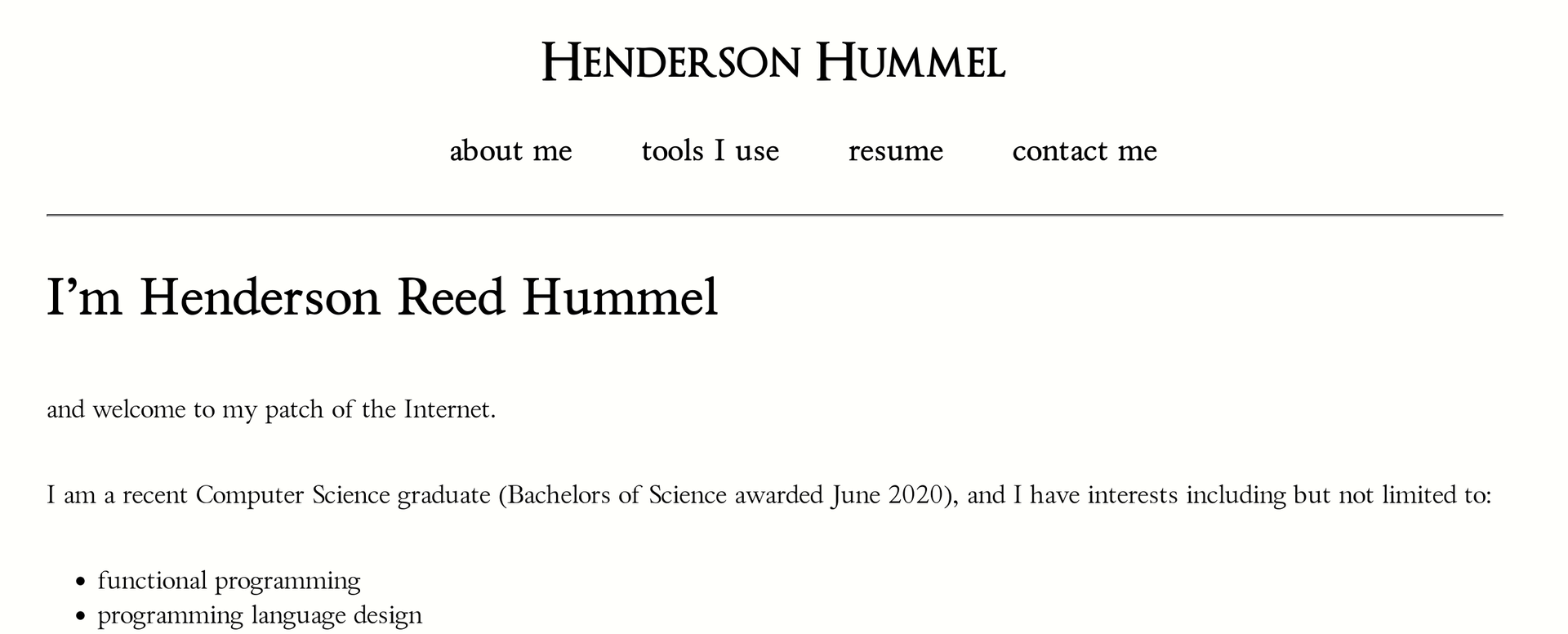
This site is, as of yesterday, feeling quite close to “done”. And so, I thought I would take a moment to describe how this site is built, some of my design and technical decisions, and maybe do a little storytelling along the way.
Why don’t we start with the storytelling?
My first website was handrolled HTML and CSS, hosted on the
university servers, at ~hhummel. I still have (most of) the
source live (you can go browse it, if you
want.)

It is, as you can see, quite sparse, in an semi-emulation of prof. dr style.
This actually was a delightful time, and I remember being very happy with the site as it was. But of course, I needed more features.
This is when I wrote my first static site generator, hatchet. That project was built, believe it or not, as a class project for a functional programming course.
Well, maybe you can tell it was built when I was very into functional programming:

As you can see, I was very into LaTeX and tried to evoke a similarly academic feeling with the visual design here. I don’t really know what I was going for, but I definitely wanted to seem professional, whatever that meant.
But disregarding my questionable design choices, the technology
behind the site was extremely minimal - hatchet had no more
sophistication than a bash script that used pandoc and
cat to generate each page. It had some bugs, it was very
minimal, and importantly, it was built without my final usecase in
mind.
That is reasonable considering my experience at the time, and the fact that I wasn’t even sure what I would be doing with the site. And I was excited about Haskell and my newfound interest in functional programming. But nonetheless, I put much more thought into writing the tool than I did into making the site easy to write for, deploy, maintain, etc etc. A tale as old as time.
This site was, after I lost access to my old uni account, hosted on a
Linode server that I paid $10 a month for (not to mention domain fees!)
And of course, deployment was at first very manual (building the site
locally, sftp-ing the files to the server.)
Eventually I built a continuous delivery cronjob that polled the GitHub repository and downloaded any changes, rebuilding the site. I was rolling everything myself. It was… unmaintainable. After building an Ansible playbook to deploy the site (right after I got hired into the Ansible org at Red Hat), it still wasn’t easy or fun and I gave up, and the site saw little-to-no updates for probably two years.
In August of 2023, I began my batch at the Recurse Center. I was excited and fired up to re-write my entire personal website. And I knew better than I did before: I knew that updating the site had to be easy for me to actually write. The tools to build the site had to be portable (because I knew that getting dependencies into CI systems can be a real pain.) I was feeling more playful than professional, and so I wanted the visual design of site to reflect that. And I wanted to move to static site hosting that was safer, free, and easier to deploy to.
My goals with the new site were straightforward:
So, psg was born
(I’ve written on it before. It is, like
hatchet, roughly as unsophisticated as a bash script that
uses pandoc and cat. But there are a few
things that, to me, make it better:
pandoc.)As a result of that last point, it’s also extremely easy to
write effective and hacky scripts that post-process your site. I’ve done
this a lot, and you can see them here.
These scripts do things like generate an ATOM feed, the blog index, my
site map (which I’ve recently updated to no longer require
tree, another system dependency (I did this by writing my
own tree replacement in python and shipping it with the
site…))
But, the reason I’m writing this post is because of the very last feature I’ve added, and I think in many ways, the final feature: true continuous delivery. This means I can now edit this site from my phone by editing source markdown through the GitHub web interface. Once it’s committed, through the magic of GitHub Actions, the site is built and deployed. You can see the file that does the magic here.